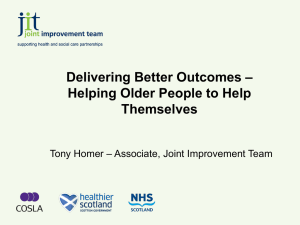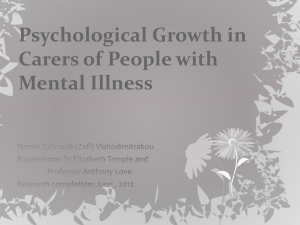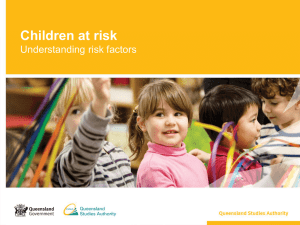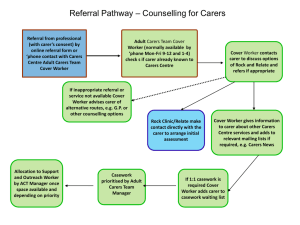Health & Adult Care Cabinet Panel Wednesday 4 July 2012 at 2pm
advertisement
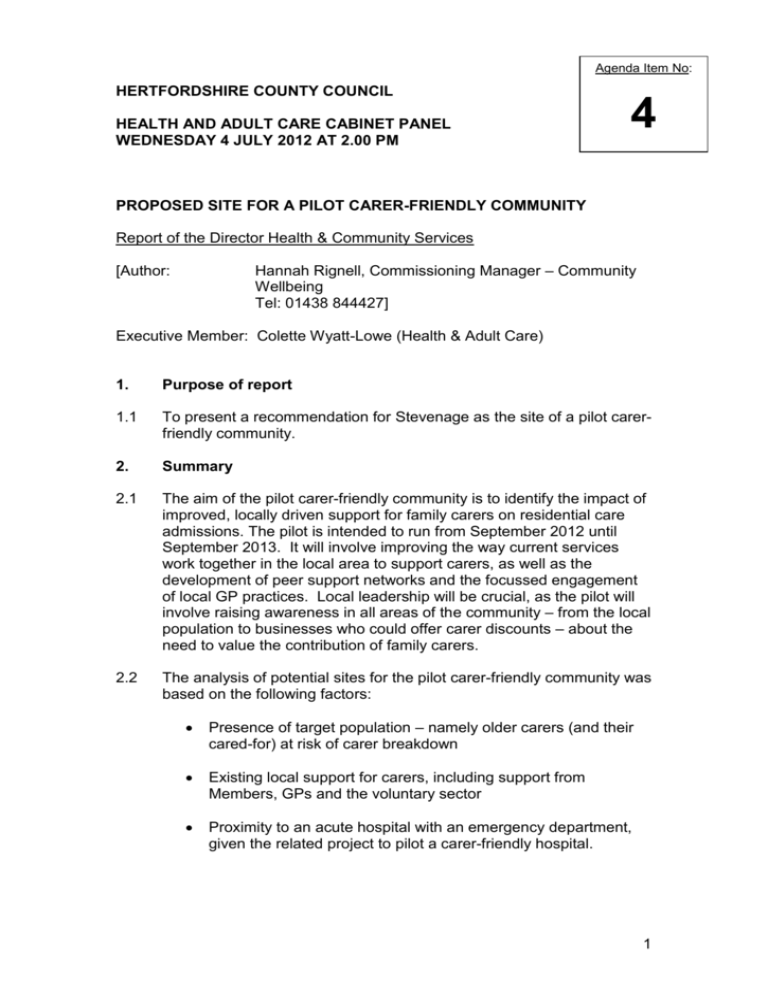
Agenda Item No: HERTFORDSHIRE COUNTY COUNCIL HEALTH AND ADULT CARE CABINET PANEL WEDNESDAY 4 JULY 2012 AT 2.00 PM 4 PROPOSED SITE FOR A PILOT CARER-FRIENDLY COMMUNITY Report of the Director Health & Community Services Hannah Rignell, Commissioning Manager – Community Wellbeing Tel: 01438 844427] [Author: Executive Member: Colette Wyatt-Lowe (Health & Adult Care) 1. Purpose of report 1.1 To present a recommendation for Stevenage as the site of a pilot carerfriendly community. 2. Summary 2.1 The aim of the pilot carer-friendly community is to identify the impact of improved, locally driven support for family carers on residential care admissions. The pilot is intended to run from September 2012 until September 2013. It will involve improving the way current services work together in the local area to support carers, as well as the development of peer support networks and the focussed engagement of local GP practices. Local leadership will be crucial, as the pilot will involve raising awareness in all areas of the community – from the local population to businesses who could offer carer discounts – about the need to value the contribution of family carers. 2.2 The analysis of potential sites for the pilot carer-friendly community was based on the following factors: Presence of target population – namely older carers (and their cared-for) at risk of carer breakdown Existing local support for carers, including support from Members, GPs and the voluntary sector Proximity to an acute hospital with an emergency department, given the related project to pilot a carer-friendly hospital. 1 3. Recommendation 3.1 The Health and Adult Care Cabinet Panel is invited to recommend to the Director Health & Community Services that Stevenage be agreed as the site of the pilot carer-friendly community. 4. Background 4.1 The underlying rationale for the carer-friendly community pilot is that it is cost-effective to help carers continue to care. In Hertfordshire, 17% of residential care admissions are the result of carer breakdown, when a carer is unable to carry on caring. This could be the result of: The carer themselves becoming ill, or having an injury which means they cannot continue to care; The cared for has a sudden deterioration as a result of a single incident (e.g. a fall) which the carer does not feel able to deal with; The cared for has a prolonged worsening of an existing condition (e.g. dementia) which leaves the carer unable to cope; The ability of the carer to continue caring is gradually worn down over time due to the demands of the caring role, leaving the carer unable to cope. There is therefore significant potential to generate savings from the residential care budget by improving the Council’s support for carers. Improved support for carers would help carers to carry on caring for longer, thereby delaying admission to permanent residential care and the associated costs. 4.2 The pilot carer-friendly community is the first phase of a wider project which aims to help carers continue to care for longer. A detailed Council for the Future business case explaining this wider project was presented to the Health and Community Services Senior Management Board in March. The aim of the first (pilot) phase is to monitor the impact of improved support to carers in a single locality on delaying residential care admissions, in comparison to control groups elsewhere in the county. If the financial benefits of the approach are proven through the pilot, the second stage of the project would involve rolling out the model to other communities throughout the county from April 2014 to April 2016. Total financial benefits to be derived over the life of the project would be £3.1m. This is based on an initial investment of £568,000 in set up costs and £445,000 in maintenance costs over the five year life of the project, and a revenue commitment of £200,000 per year thereafter. 2 4.3 The wider project also includes setting up a carer-friendly hospital in Hertfordshire and the development of a ‘Hertfordshire Commitment to Carers’. The hospital, and in particular emergency care, is a key point for many carers in their caring journey, so interventions at this point are likely to be cost effective. The carer-friendly hospital will: routinely collect carer data have strong clinical leadership to raise awareness of the carers’ agenda at all levels hold expert patient training programmes for carers and Carers’ Clinics within the hospital There are strong links to the carer-friendly community pilot; for example, a more carer-friendly community may have an impact on emergency hospital admissions as a result of carer breakdown. For this reason, selecting a community with an acute hospital is recommended here. 4.4 The Hertfordshire Commitment to Carers (HCtC) is used to describe what every carer should expect to have access to, wherever they happen to ‘hit the system’. The key lever for embedding this will be a monitoring and accreditation system, where organisations signed up to the ‘Hertfordshire Commitment to Carers’ have to demonstrate they are meeting the minimum offer to carers. It is anticipated that this will be led by and for carers. The carer-friendly community will demonstrate the potential of the HCtC as it involves implementing it in a focussed way with local organisations in a specific locality. 4.4 The comparative analysis of potential sites for the pilot carer-friendly community is attached at Appendix A. In summary, the rationale for recommending Stevenage is as follows: Stevenage has a consistently high number of households likely to have a regular and substantial carer, with a cared-for who is likely to be council-funded if they enter residential care (as according to a Mosaic ‘profile’ of households likely to have a regular and substantial carer, attached at Appendix B). It has the second highest proportion in Hertfordshire of retired people living in areas where older people experience deprivation. Lister Hospital (East & North Herts NHS Trust) is based in Stevenage, a hospital with an emergency department relatively close to the town centre. This means the carer-friendly hospital could be piloted in the same locality, allowing the joint benefits of a carer-friendly local health and social care system to be measured. Stevenage has the highest rate of emergency admissions for falls amongst over 65s in Hertfordshire. 3 Stevenage has a high number of residential care admissions in a relatively small area and relatively small population. This would make the role of the first Development Co-ordinator easier logistically. It is also justifiable in terms of the investment per residential care admission for the locality. Existing local carer support is strong. Stevenage Borough Council retains a local health and wellbeing partnership, and their community strategy includes a commitment to developing the provision of preventive carers support. Carer-led peer support groups meet regularly in the area and are well attended. Voluntary sector services, specific to Stevenage, include Crossroads Day Centre, Douglas Drive Day Centre, and GEMMS day service. 4.5 The carer-friendly community is a completely new innovation which has not been tried elsewhere. Maximising the chances of success therefore means selecting a relatively compact locality which has some existing level of carer awareness, as well as substantial numbers of residential care admissions. Success in Stevenage will prove the validity of the underlying argument – that supporting carers is cost effective – whilst also allowing lessons to be learned about how it might be implemented in different communities. 5. Financial Implications 5.1 The total cost of piloting the carer friendly community will be £60,000. A saving of £50,000 from delaying residential care admissions is anticipated, to accrue from helping eight carers continue to care for one year. 6. Equalities Implications 6.1 Carers of elderly or disabled people are explicitly protected under the Equalities Act 2010 by association with their cared-for. The law protects these carers against direct discrimination or harassment due to their caring responsibilities. In this sense, the pilot will advance equality of opportunity for these carers (and, by association, their cared-for) as it aims to make a whole community carer friendly. 6.2 However, carers are not a homogenous group. Older people are more likely to have caring responsibilities, but the number of younger carers is growing. In Hertfordshire in 2001, 6% of all carers were under the age of 24. Young carers under the age of 18 often have different experiences to older carers in balancing school work, friends, and the individual which they care for. Similarly, carers from different cultural groups will experience their caring responsibilities differently: Black African, Indian and in particular Bangladeshi and Pakistani people have an above average likelihood of becoming carers, with those from the Bangladeshi and Pakistani communities 2.5 times more likely to become carers compared to their white counterparts. There are also 4 cultural assumptions that “they look after their own” which place additional challenges in the way of BME carers getting support1. 6.3 The design of the carer friendly community pilot will need to reflect the different needs of these different types of carers. Importantly, the carerfriendly community model will allow this approach by facilitating improved support for carers which is specific to the needs to the local population. The evaluation of the pilot will need to include equalities monitoring data to ensure this is the case. 1 Carers UK Who Cares? Geographic variation in unpaid caregiving in England and Wales: evidence from the 2001 Census –Office of national Statistics 5


